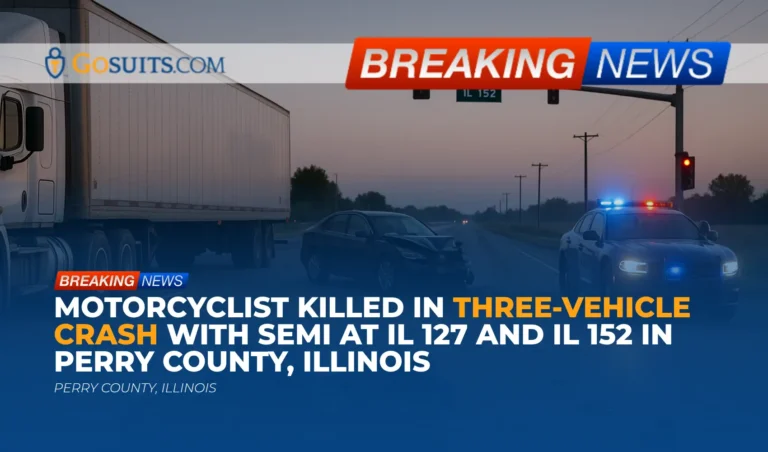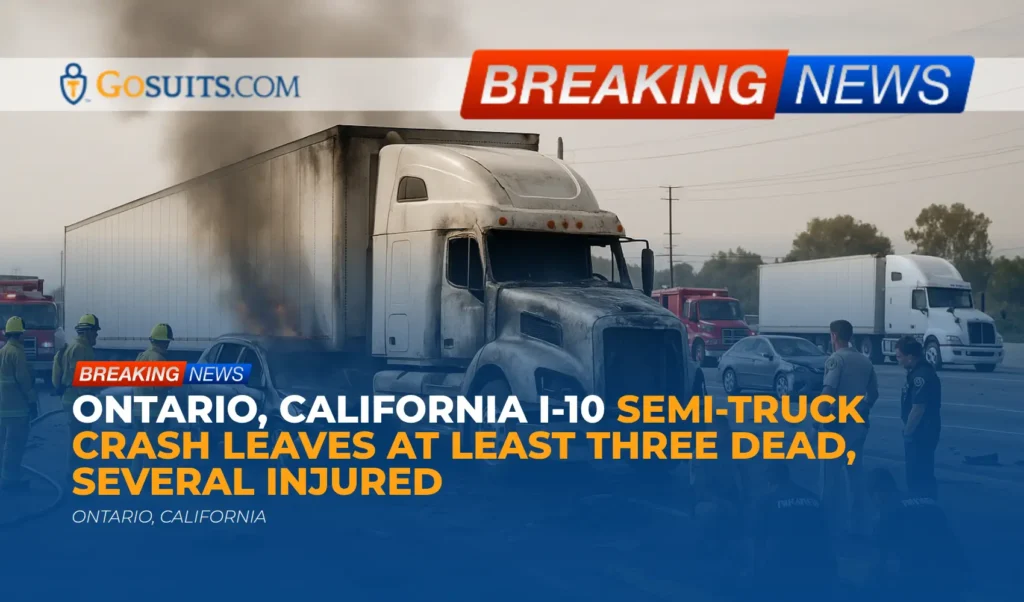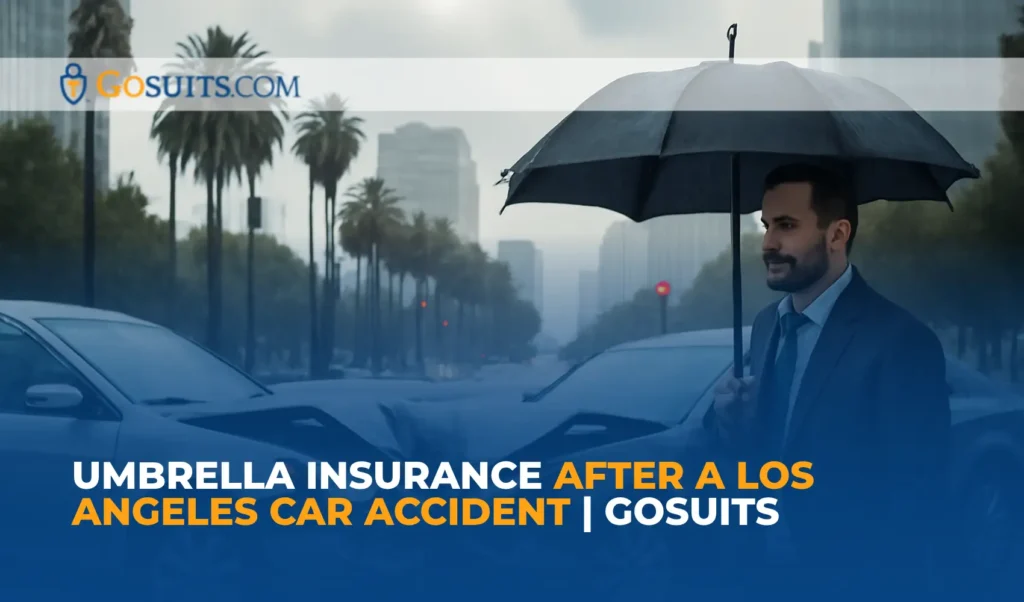- What is known about the Perry County, Illinois crash
- Why multi-vehicle crashes with motorcycles and semi-trucks are complex
- Immediate steps families often consider after a fatal crash
- Key records to request and who to contact
- Understanding Illinois civil claims after a fatal crash
- Insurance and financial responsibility in Illinois
- Evidence to preserve in truck-involved collisions
- Safety and prevention insights
- Where to find official updates
- Grief, support, and practical help
- Commentary from Gosuits Perry County, Illinois Personal Injury Attorney
- Time-sensitive steps to consider
What is known about the Perry County, Illinois crash
Perry County, Illinois authorities responded to a three-vehicle collision early Tuesday morning at the intersection of State Highway 127 and State Highway 152. According to initial reports, the Illinois State Police Troop 10 arrived around 4:40 a.m. The crash involved a motorcycle, a passenger vehicle, and a truck tractor semi-trailer. The motorcyclist was pronounced deceased at the scene. The roadway was shut down to allow investigators to document evidence and reconstruct the events. As of the latest update, additional details such as identities, specific contributing factors, and sequence of impacts have not been publicly released.
When a fatal crash occurs before sunrise, investigators typically assess lighting conditions, sight lines at the intersection, traffic control devices, vehicle damage patterns, skid and yaw marks, and digital data from vehicles and commercial trucks. In multi-vehicle incidents, the order of impacts and the movements of each vehicle matter greatly. It is common for authorities to take several days or longer to compile a preliminary crash report and for specialized teams to conduct follow-up analyses.
Why multi-vehicle crashes with motorcycles and semi-trucks are complex
Crashes that involve a motorcycle, a passenger car, and a semi-truck present unique challenges. Motorcycles offer little physical protection, and even moderate-speed impacts can be fatal. Nationally, motorcyclists are at heightened risk compared to occupants of enclosed vehicles. Federal safety analyses recognize that motorcyclists face substantially greater fatality risk per mile traveled than passenger vehicle occupants, and visibility at intersections is a recurring factor in serious motorcycle collisions. See the National Highway Traffic Safety Administration’s motorcycle safety materials for context on risk and visibility concerns NHTSA.
Intersections are particularly hazardous because multiple streams of traffic converge, sometimes with complex control patterns. Federal highway safety guidance highlights intersection-related conflict points and the importance of approach speeds, sight distance, and clear traffic control devices Federal Highway Administration. When a commercial truck is involved, additional factors come into play: longer stopping distances, wider turning radii, potential blind spots, driver hours-of-service compliance, vehicle condition, and cargo securement. Federal Motor Carrier Safety Regulations govern many of these issues, including driver hours of service 49 CFR Part 395, required drug and alcohol testing protocols 49 CFR Part 382, and minimum levels of financial responsibility for motor carriers 49 CFR 387.9.
Because evidence can come from three different vehicles, multiple drivers, and possibly different insurers, it is crucial to identify, obtain, and preserve records early. This is especially true for electronic logging device data and company records that, under federal rules, may be retained for limited periods.
Immediate steps families often consider after a fatal crash
Every loss is personal. In the days after a tragedy, practical needs and questions arise quickly. The following steps are general information to help navigate common tasks after a fatal roadway crash.
- Wait for official identification and initial findings. Local authorities and the Illinois State Police typically confirm identity and notify next of kin. Crash reconstruction can take time; patience protects the integrity of the investigation.
- Obtain the police crash report and any supplements. Illinois State Police publish crash reports when available. Instructions for obtaining reports are provided by the agency Illinois State Police.
- Contact the county coroner’s office regarding the death investigation. In Illinois, coroners conduct inquests and maintain related records under state law 55 ILCS 5/3-3013 and 55 ILCS 5/3-3014. Families can ask about autopsy status, cause and manner of death, and timing of inquest proceedings.
- Request certified death certificates. Certificates are needed for many matters, including estate administration and insurance claims. The Illinois Department of Public Health explains how to request death records IDPH.
- Preserve documents and digital evidence. Keep photographs, dashcam footage, phone records, and contact information for witnesses. For crashes involving a commercial truck, prompt preservation requests can be critical because some electronic records have short retention periods 49 CFR Part 395.
- Consider appointing an estate representative. Many civil claims arising from a death are brought by the personal representative of the estate. If needed, the probate court can appoint a representative to handle these responsibilities.
- Speak with a seasoned attorney before talking to insurance companies. What is said to an adjuster can be recorded and later used to limit or deny a claim. A confidential, no-cost consultation can help clarify rights and next steps before contacting insurers.
Key records to request and who to contact
Police crash report and reconstruction materials
The Illinois State Police maintain crash reports and explain how the public may obtain them through their reporting process Illinois State Police. In major or fatal collisions, there may be supplemental materials such as scene diagrams, measurements, photographs, and reconstruction analyses. Request the full report number and any available supplements. If additional public records are needed, families can consider a request under the Illinois Freedom of Information Act, which sets the framework for access to public records 5 ILCS 140.
Coroner’s files and autopsy/inquest records
Illinois coroners are tasked with investigating certain deaths and may convene an inquest jury. The statute describing inquests and record-keeping is found at 55 ILCS 5/3-3013 and 55 ILCS 5/3-3014. Families can ask the coroner’s office about the availability of autopsy reports, toxicology results, and inquest verdicts, as well as any waiting periods for release.
Death certificate
Certified death certificates are issued through local or state vital records offices. The Illinois Department of Public Health provides instructions, eligibility criteria, and ordering options for death records IDPH.
Commercial motor carrier records
Where a truck tractor semi-trailer is involved, additional evidence may exist beyond the police file. Federal rules require retention of certain records for defined periods, including hours-of-service and electronic logging device records 49 CFR Part 395, and maintenance and inspection materials 49 CFR Part 396. Prompt written requests to preserve relevant data can help ensure important information is not overwritten or destroyed in the ordinary course of business.
Roadway and traffic data
The Illinois Department of Transportation publishes statewide crash data and annual reports that offer context on traffic safety trends, including motorcycle-involved crashes and intersection risks IDOT Roadway Crash Data. While these resources do not determine fault in a specific incident, they can provide helpful background.
Understanding Illinois civil claims after a fatal crash
Illinois law provides civil pathways for families to seek accountability after a wrongful death. Although each case depends on the facts, the following statutes often come into play.
Wrongful Death Act
Illinois’ Wrongful Death Act allows a claim when a death is caused by the wrongful act, neglect, or default of another. The action is brought for the benefit of the surviving spouse and next of kin, and damages are distributed according to the court’s determination of dependency and the statute’s guidance. See 740 ILCS 180. The statute generally requires that such actions be filed within two years of the date of death, subject to limited statutory exceptions 740 ILCS 180/2.

Survival Act
Separate from wrongful death, the Survival Act permits certain claims the decedent could have pursued had they lived, such as pain and suffering before death and medical expenses. These claims become part of the estate and are brought by the estate’s representative. See 755 ILCS 5/27-6.
Comparative negligence in Illinois
Illinois follows a modified comparative negligence system. If a plaintiff’s contributory fault is more than 50 percent of the proximate cause of the injury or damage, recovery is barred; otherwise, recoverable damages are reduced by the plaintiff’s percentage of fault. See 735 ILCS 5/2-1116. In a multi-vehicle crash, fault can be apportioned among multiple drivers and entities, including a commercial motor carrier if evidence supports it.
Potentially responsible parties
Depending on the evidence, civil claims may involve multiple parties:
- Passenger vehicle driver for negligent driving maneuvers such as failure to yield at an intersection or unsafe lane use.
- Commercial truck driver for unsafe operation, hours-of-service violations, or other breaches of duty.
- Motor carrier company for negligent entrustment, hiring, training, supervision, or vehicle maintenance, including potential federal regulation violations 49 CFR Part 396.
- Others such as a shipper or maintenance contractor if the facts support involvement.
Determining who is legally responsible requires a careful review of all available records and may involve accident reconstruction and expert analysis.
Insurance and financial responsibility in Illinois
Insurance is a practical foundation for most civil recoveries after a crash. Illinois requires minimum liability coverage for motor vehicles of at least $25,000 for bodily injury per person, $50,000 per crash for bodily injury, and $20,000 for property damage 625 ILCS 5/7-203. Illinois policies also must include uninsured motorist bodily injury coverage, and underinsured motorist coverage is governed by statute 215 ILCS 5/143a and 215 ILCS 5/143a-2.
For commercial motor carriers operating a truck tractor semi-trailer, federal regulations require minimum levels of financial responsibility that are typically higher than personal auto policies. For most for-hire carriers transporting property in interstate commerce, minimum coverage is generally at least $750,000, and higher for certain hazardous cargoes 49 CFR 387.9.
Because multiple policies can apply in a multi-vehicle crash, communication with insurers should be thoughtful and strategic. It is common for insurance representatives to request recorded statements early. Speaking with an attorney first can help ensure that rights are protected, as statements may later be used to contest fault or damages.
Evidence to preserve in truck-involved collisions
Key evidence can fade quickly after a crash, especially when a commercial carrier’s systems automatically overwrite data. Early, written preservation requests are often used to notify relevant parties to keep specific categories of evidence. Examples include:
- Electronic logging device (ELD) and hours-of-service data. Federal rules govern driver hours and the retention of records of duty status, with many records retained for at least six months 49 CFR Part 395.
- Truck inspection, repair, and maintenance records. Carriers must systematically maintain and retain these records 49 CFR Part 396.
- Driver qualification and training files. These can include background checks, road tests, and ongoing training materials under federal and company policies.
- Drug and alcohol testing records. Post-crash testing is governed by federal rules in specified circumstances 49 CFR Part 382.
- Dash cameras and fleet telematics. Many carriers use inward- and outward-facing cameras and telematics that capture speed, braking, and GPS data.
- Passenger vehicle and motorcycle data. Some vehicles maintain event data recorder information that can provide speed, throttle, and braking inputs.
- Scene and intersection evidence. Photographs, roadway markings, debris fields, and traffic signal timing data can be important, especially at intersections.
Preservation letters typically identify the crash, list categories of evidence to retain, and request that normal deletion schedules be suspended. While these letters do not compel production by themselves, early notice helps prevent the loss of critical information that may later be requested through formal processes.
Safety and prevention insights
Without assigning fault, it is appropriate to acknowledge the factors that often play a role in severe crashes at intersections involving motorcycles and large trucks.
- Visibility and gap selection. Drivers turning across or into a motorcyclist’s path sometimes misjudge distance and speed. Federal safety materials emphasize the added vulnerability of motorcyclists and the importance of looking twice at intersections NHTSA.
- Intersection design and control. Intersection conflict points and approach speeds influence crash risk. Proven safety countermeasures include improved signal timing and sight lines where appropriate FHWA.
- Commercial vehicle dynamics. Heavy trucks require longer stopping distances and wider turns. Compliance with hours-of-service, attentive driving, and proper vehicle maintenance are essential 49 CFR Part 395 and 49 CFR Part 396.
- Low-light conditions. Early morning hours bring reduced contrast and glare from oncoming lights. Riders and drivers benefit from lighting, reflective gear, and heightened caution.
While infrastructure and policy choices can foster safer roads over time, individual attention to intersection approaches, scanning, and speed control remains vital for everyone’s safety.
Where to find official updates
For this incident, updates often come from the Illinois State Police, which publish instructions for obtaining crash reports and may release public information as investigations proceed Illinois State Police. Statewide data and safety information are maintained by the Illinois Department of Transportation IDOT.
Grief, support, and practical help
Sudden loss in a traffic crash is devastating. In addition to immediate family and community support, some families seek counseling or practical guidance. The Illinois Department of Human Services maintains information about mental health services and community resources that can help people navigate grief and stress-related needs Illinois DHS. Faith communities, local hospitals, and victim support groups can also be valuable sources of care.
For practical matters, certified death certificates, the coroner’s findings, and the police crash report form a core set of documents for closing accounts, addressing insurance, and considering potential claims. If an estate needs to be opened, the probate court in the decedent’s county of residence can appoint a representative to handle legal and financial matters on behalf of the estate.

Commentary from Gosuits Perry County, Illinois Personal Injury Attorney
Our hearts go out to those affected by the tragic loss reported at State Highway 127 and State Highway 152. This article is offered for general information to help the community understand typical next steps and the kinds of records that become important after a fatal crash.
Based on publicly available information, this was a multi-vehicle collision involving a motorcycle, a passenger car, and a semi-truck before sunrise. In our experience, cases like this require careful attention to intersection geometry, traffic control, vehicle movements, and the timing of each driver’s actions. When a commercial motor carrier is involved, it is also important to evaluate federal motor carrier compliance and to secure company records that can shed light on driver hours, training, and vehicle condition.
Insurance companies and large corporations have adjusters and risk teams who act quickly. It is common for early questions and recorded statements to be framed in ways that minimize financial exposure. Many families do not realize how a single phrase in a recorded call can later be used to challenge fault or reduce the value of a claim. Early, informed guidance helps level the playing field so decisions are grounded in full information rather than pressure.
A confidential, free consultation can help anyone affected understand potential timelines, the difference between wrongful death and survival claims, and how to protect critical evidence. It can also clarify how multiple insurance policies might intersect in a three-vehicle crash, including commercial coverage for a truck tractor semi-trailer and any available uninsured or underinsured motorist coverage.
Time-sensitive steps to consider
- Secure core records promptly. Request the Illinois State Police crash report when available, ask the coroner about autopsy and inquest timelines, and order certified death certificates as needed for legal and financial matters.
- Preserve evidence before it is lost. Send written preservation requests to involved parties to safeguard electronic logging device data, dashcam footage, vehicle event data, and maintenance records that can be overwritten or purged on a schedule.
- Be cautious with insurance communications. Consider getting guidance before speaking on the record with any insurer. What is said early can be used later to dispute liability or damages.
- Identify all potential coverage. Multi-vehicle crashes can implicate several policies, including commercial motor carrier coverage and uninsured/underinsured motorist benefits. Cataloging these early can shape the strategy for claims.
- Document the human impact. Keep organized records of funeral expenses, loss-related costs, and the lived effects on the family. Contemporaneous documentation helps ensure the full picture is recognized in any civil claim.
- Mind the legal timelines. Illinois law includes specific filing deadlines for civil actions related to wrongful death and survival claims. Acting without delay helps ensure options remain available.
- Focus on well-being. Coordinate support from family, community, and care providers. Practical steps have more clarity when grief and immediate needs are acknowledged and supported.
References
- Illinois State Police – Crash Reports
- Illinois Department of Transportation – Illinois Roadway Crash Data
- Illinois Department of Public Health – Death Records
- 740 ILCS 180 – Wrongful Death Act
- 755 ILCS 5/27-6 – Survival Act
- 735 ILCS 5/2-1116 – Comparative Negligence
- 625 ILCS 5/7-203 – Minimum Liability Insurance
- 215 ILCS 5/143a – Uninsured Motorist Coverage
- 215 ILCS 5/143a-2 – Underinsured Motorist Coverage
- 55 ILCS 5/3-3013 – Coroner’s Inquest
- 55 ILCS 5/3-3014 – Inquest Records
- 5 ILCS 140 – Illinois Freedom of Information Act
- 49 CFR Part 395 – Hours of Service and ELD
- 49 CFR Part 396 – Inspection, Repair, and Maintenance
- 49 CFR Part 382 – Drug and Alcohol Testing
- 49 CFR 387.9 – Minimum Financial Responsibility
- NHTSA – Motorcycle Safety
- FHWA – Intersection Safety
- Illinois DHS – Mental Health Services






